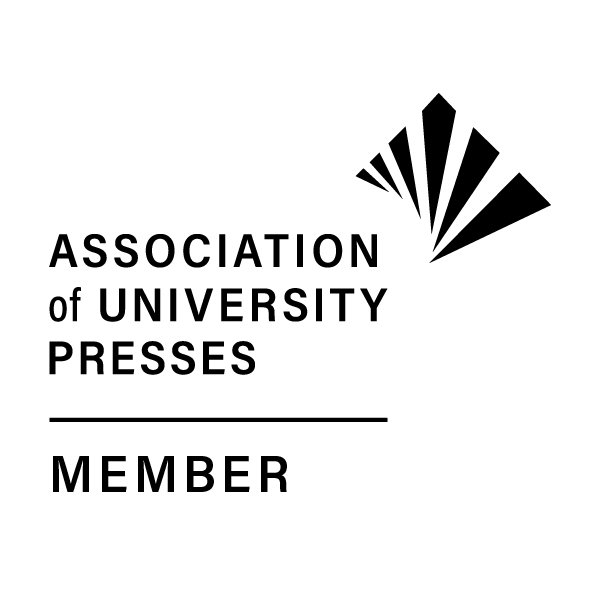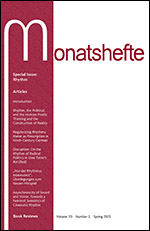
|
|
MonatshefteVolume 109, Number 2, Summer 2017 Table of ContentsSpecial Issue: Weimar Photography in Context
ARTICLES Carolin Duttlinger and Silke Horstkotte Introduction: Weimar Photography in Context. Typology, Sequentiality, Narrativity
Wolfgang Brückle Not in the Baedeker. Photography and the Physiognomy of the Metropolis in Weimar Germany Photography has been extensively used in traditional physiognomy, as well as contributing to the fashion of reading other aspects of modern life physiognomically. In the hermeneutic discourse of the Weimar period, the trope of face became a crucial tool for reading all kinds of phenomena physiognomically, searching for hidden links and connections between different aspects of social life. Photography’s ability to register any minute detail of the surface of the world, and its supposed limitation to recording only that which reveals itself to the lens, made it a welcome tool for such physiognomic readings. Physiognomic thinking also became a meeting ground for conceptualising urban experiences and reflections on the medium of photography. The flânerie of the modern city dweller was not only a product of contemplating photographs, it also provided opportunities for photographers, and the specificity of photography as a medium may have helped to trigger a physiognomic analysis of urban environments.
J. J. Long Faces. Antlitz and Gesicht in the Weimar Republic Photobook It is widely accepted that the Weimar Republic witnessed an upsurge in interest in physiognomy. However, once physiognomy is allied with the technical media, the situation is complicated by an ambiguity that arises as to where the signifying power lies: is it in the face, or is it in the representation? Starting from this question, the present article investigates two sets of photographic books, each including examples from the left and right of the political spectrum, that invoke physiognomy in their titles or their visual practice. It emerges that while publications from the left tend to be more overtly critical of physiognomy and subvert it in various ways, the verbal and photographic discourse of rightwing publications also tends to undermine the claims of physiognomy in one way or another. Physiognomy thus emerges as a practice that is both politically manipulable and epistemologically highly unstable, whose enlistment in support of a variety of political positions goes hand in hand with a critique from within.
Silke Horstkotte Inkongruente Bilder. Ernst Jüngers Pferde Photobooks played a central role in Weimar Germany’s memory culture. They served as a medium for preserving and archiving, illustrating and communicating recollections of WW I. In the politicized climate of the Weimar years, photobooks spoke to distinct memory communities situated at different points on the political spectrum. This article considers the photobooks of Ernst Jünger, an important figure in the memory culture of the political right. It focuses on a number of incongruent images in Jünger’s Das Antlitz des Weltkrieges: photographs of dead and dying horses that extend the notion of wartime suffering to animals. Because they do not sit easily within the book’s program of a commemoration of the dead, and because they do not fit Jünger’s explicitly stated understanding of the War as a crucible of modernization, these images provide the opportunity for a more differentiated consideration of Jünger’s contribution to Weimar memorial culture.
Carolin Duttlinger From Photography to Film and Back Again. Helmar Lerski’s Dramaturgy of the Human Face Helmar Lerski’s Köpfe des Alltags (1931) stands out among Weimar photobooks for its experimental approach to photographic narrativity. By moving away from the single, representative portrait to the photo-group or series, Lerski tries to capture human identity in its intrinsic diversity. His expressive portraits and sequential arrangements reflect his background as a cameraman working on silent film productions. Yet his answer to film is not simply to invest his images with a narrative quality but rather to play with the viewer’s preconceptions. The article shows how the arrangement of his photos blurs the boundaries between sitters and challenges the notion of identity as stable and discrete. Lerski’s recording method, in turn, reveals the inherent contradictions of his approach: while purporting to put those at the margins of society center stage, he demands complete passivity from his models to enact his creative vision.
Wim Peeters Bilder des „überflüssigen“ und des „erfolgreichen“ Menschen um 1930 The images of the ‘Arbeiterfotograf’ Walter Ballhause have a sense of gritty realism. Ballhause recorded his images of people queueing at the unemployment office with a hidden camera, at a time when he was himself unemployed. They can thus be read as counterparts to a second discourse in Weimar photography: the iconography of the successful person, a fixed topos in magazines and self-help guides, where staged images using actors were presented to viewers as an aspirational ideal. Ballhause’s images also contrast with the photo documentations of Walker Evans and Dorothea Lange, which were designed to communicate a specific idea of victimhood. His photos originate in the moment and in a coincidental meeting between photographer and photographic subject. Their revealing character lies precisely in the fact that the portrayed persons go about their everyday business without any obvious posing for the camera.
Daniel H. Magilow April Fools’ in Weimar: Photography and Crisis in the Illustrierten Each April 1st, the popular glossy tabloids known as Illustrierte published a series of mischievous April fool jokes. In this annual game of discerning the real news from the fake, prominent magazines tricked readers unable or unwilling to exercise their critical faculties by interspersing manipulated photographs amid the familiar array of advertisements, serialized novels, puzzles, and articles of the Illustrierten. Often critiqued as manipulating their naïve readers, the magazines’ use of fake photographs and the mixed message of their satirical sight gags astutely comment on the notion that “the camera does not lie”. Their interweaving with serious photojournalism pieces complicates the arguments of critics that the Illustrierten were exclusively naïve purveyors of distraction. Far from being trivial, April fool jokes reflect and refract the obsessions of Weimar popular culture with such modern themes as mechanical movement, sensational spectacle, or miraculous weight loss.
Bernd Stiegler Technikfotografien. Aufnahmen aus dem Reich der Freiheit und der Notwendigkeit The late 1920s saw an eruption of photographs picturing feats of technical construction: metal bridges, machine parts, steel construction, furnaces, and factories. The seemingly recalcitrant field of industrial technology became the target of an aesthetic fascination that produced many spectacular photobooks. But debates about the photography of technology were characterized by a deep ambivalence. On the one hand, technology was celebrated as sublime; on the other, the downside of mechanization was criticized. Avantgarde photographs of technology walked a narrow path between the glorification of technology and a critical inventory. This ambivalence is discussed through a comparison between the photographers Germaine Krull and Margaret Bourke-White, both of whom produced important photobooks and essays about technology.
Michael W. Jennings The Agency of Things. Infrastructural Space in Weimar Industrial Photography In the 1920s in Germany and America, a new motif emerged in photography: the photography of industrial architecture. But the manner in which Weimar photographs make industrial structures visible stands in stark contrast to the Weimar program of Neues Sehen (New Vision). New Vision photographers, with a new range of representational strategies at their disposal—radical perspectives, negative images, photograms, etc.—sought to make the world available in ways that allowed viewers a fresh view onto their environment. The industrial photographers, in contrast, felt no need to defamiliarize their motifs in order to resensitize perception to an environment that had become invisible through habituated daily use. Instead, they treated their architectural objects as represented sculptures by focusing more on the negative space around the objects than on the objects themselves.
BOOK REVIEWS Ächtler, Norman, Hrsg., Alfred Andersch. Engagierte Autorschaft im Literatursystem der Bundesrepublik (Marcus Bullock) Aurnhammer, Achim und Ulrich Bröckling, Hrsg., Vom Weihegefäß zur Drohne. Kulturen des Heroischen und ihre Objekte (Jost Hermand) Baer, Hester and Alexandra Merley Hill, eds., German Women’s Writing in the Twenty-First Century (Linda Shortt) Bengtsson, Staffan, Heinrich Clairmont, Robert E. Norton, Johannes Schmidt, and Ulrike Wagner, eds., Herder and Religion (Joseph D. Rockelmann) Bernauer, Markus und Mirko Gemmel, Hrsg., Realitätsflucht und Erkenntnissucht. Alkohol und Literatur (Hansjakob Werlen) Brandt, Bettina and Daniel Leonhard Purdy, eds., China in the German Enlightenment (Weijia Li) Bühler, Benjamin, Ecocriticism. Grundlagen – Theorien – Interpretationen (Sabine Wilke) Dietrick, Linda und Birte Giesler, Hrsg., Weibliche Kreativität um 1800. Women’s Creativity around 1800 (Gail Finney) Frackman, Kyle and Larson Powell, eds., Classical Music in the German Democratic Republic (Joachim Lucchesi) Gansel, Carsten und Monika Wolting, Hrsg., Deutschland- und Polenbilder in der Literatur nach 1989 (Karolina May-Chu) Giuriato, Davide, “klar und deutlich”. Ästhetik des Kunstlosen im 18./19. Jahrhundert (Anne Lepper) Görbert, Johannes, Die Vertextung der Welt. Forschungsreisen als Literatur bei Georg Forster, Alexander von Humboldt und Adelbert von Chamisso (Florian Krobb) Greif, Stefan, Marion Heinz und Heinrich Clairmont, Hrsg., Herder Handbuch (John H. Zammito) Gwyer, Kirstin, Encrypting the Past: The German-Jewish Holocaust Novel of the First Generation (Lynn L. Wolff) Hachmann, Gundela, Zeit und Technoimagination. Eine neue Einbildungskraft in Romanen des 21. Jahrhunderts (Christiane Steckenbiller) Hoffmann, Torsten, Körperpoetiken. Zur Funktion des Körpers in der Dichtungstheorie des 18. Jahrhunderts (Fabian Goppelsröder) Hoffman-Schwartz, Daniel, Barbara Natalie Nagel, and Lauren Shizuko Stone, eds., Flirtations: Rhetoric and Aesthetics This Side of Seduction (Damianos Grammatikopoulos) Krumrey, Birgitta, Ingo Vogler und Katharina Derlin, Hrsg., Realitätseffekte in der deutschsprachigen Gegenwartsliteratur. Schreibweisen nach der Postmoderne? (Leonhard Herrmann) Moore, Evelyn K., The Eye and the Gaze: Goethe and the Autobiographical Subject (Franz R. Kempf) Pabst, Stephan, Post-Ost-Moderne. Poetik nach der DDR (Hunter Bivens) Prager, Brad, After the Fact: The Holocaust in Twenty-First Century Documentary Film (Judith Keilbach) Reiser, Simon, Totengedächtnis in den Kreisen um Stefan George. Formen und Funktionen eines ästhetischen Rituals (Rolf J. Goebel) Rode-Breymann, Susanne und Antje Tumat, Hrsg., Der Hof. Ort kulturellen Handelns von Frauen in der Frühen Neuzeit (Inci Bozkaya) Twark, Jill E. and Axel Hildebrandt, eds., Envisioning Social Justice in Contemporary German Culture (Valentina Glajar) Vecchiato, Daniele, Verhandlungen mit Schiller. Historische Reflexion und literarische Verarbeitung des Dreißigjährigen Kriegs im ausgehenden 18. Jahrhundert (Peter Höyng) Zilcosky, John, Uncanny Encounters: Literature, Psychoanalysis, and the End of Alterity (Caroline Rupprecht)
BOOKS RECEIVED |

